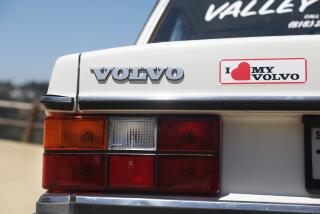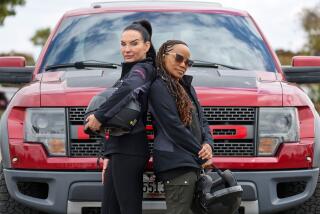Vehicles That Offer Women a Macho Trip
It’s easy to see the appeal of today’s sport-utility vehicles. Picture them fording streams on their big tires. Watch them climbing buttes with their four-wheel drives. They’re tough and outdoorsy and macho, a man’s car for a man’s man.
Or for a woman. Likely as not, the people behind the wheels of Broncos and Blazers, of Cherokees, Wranglers or Explorers are female. Many are wearing full makeup and tossing around three pounds of Wella Balsam hair. Some are drying their nails, fanned out against the wheel. But they’re as tough and outdoorsy as any of the men driving these things, which is to say not very.
This is the macha market, and it could be a really big deal. It’s only the beginning, of course: It could also get botched up.
Sport-utility vehicles are, as the name implies, crossovers, with a foot in each ethos: Built on truck chassis, they’re technically trucks, designed for the upscale car market.
It all started with the pickup truck. First they enclosed the back, creating the “utility” vehicle. Then they brought it out in compact form, which made it more sporting. They even made it possible for the driver to kick in the four-wheel drive with an inside button or knob, without stopping or getting out.
The result was a marketing dream. Sport-utility vehicles “imply some sort of fun component,” says Dave Hudgens, spokesman for Chevrolet in Michigan, “plus the ability to do useful work.” By the end of the decade, they represented 15% of the truck market.
Actually, this market isn’t so much dream as fantasy. Forget sport. Forget utility. It seems no more than 5% of the people who buy such off-road vehicles ever go off-road in them, and even fewer (maybe 1%) ever actually use the four-wheel drive. At least one model--an Isuzu Rodeo--doesn’t even have four-wheel drive: It just looks like it does.
“The reason why people are buying them really has nothing to do with what they do,” says Jay Houghton, a partner in Detroit’s Automotive Information Group, an independent research firm. “Nobody needs a four-wheel-drive truck for city use, the fuel economy’s terrible, and they may not be so great on a smooth asphalt surface.”
But the owner makes a hell of a statement--to himself, to herself, or to anyone else who’ll notice. Declares one woman, it says, “I’m outdoorsy, I can take care of myself, don’t mess with me.”
Indeed, herself may be speaking a good half the time, and maybe more. The Ford Explorer, a plush sport-utility vehicle introduced last year, is 46% female-owned in the four-door version (the family choice) and 40% in the two-door (single owners). The percentage driven by women is probably higher.
The auto industry claims to have sensed early on that women were a good part of the market--somewhere about the same time it was realizing, belatedly, that women could be principal drivers of any vehicle. In fact, and in hindsight, they say the compact versions of both vans and sport-utility vehicles were specifically introduced for women.
What’s more, the industry understands the appeal to women. Women, say auto folk, want the traction of four-wheel drive on snow and ice, in field and stream. They like being able to tow their boats, their dirt bikes and their snowmobiles. Sure they do.
But there’s another level, they say--the emotional. Women like the sense of safety and security they get knowing they have four-wheel drive. They like the size and strength of the truck frame, the fact that the vehicle is “set higher, and they can see all around, feel more in control of the environment,” says Kurt Ritter, marketing manager for Chevrolet trucks. They’re in what Woody Haines, spokesman for Ford truck operations, calls the “command position.”
“Command position”? This has anything to do with safety and security? Naah, we’re into image here--not so much power as the feeling of power, the look of power. We’re into macho.
This is uplifting. Seriously. Respect, jobs, equal pay are important, but true equality is when women can have the same totally unnecessary, purely posturing accessories as men have.
There’s something big here that probably goes beyond cars, although the auto industry deserves full credit for discovery, and what they’re doing with their discovery of the women’s market is instructive. They’re serving up nicer interiors, more attractive instrument panels, softer seating. They’re tooling up special models for women. Basically, they’re wimping up the category: Here come the Bronca, the Rodea, the Navaja, the Wagonette.
In fact, because the industry recognizes the potential market, and may only partly understand it, we’d better brace ourselves. Someone will give the marketing guys at other companies the sport-utility sales stats and a tape of “Thelma & Louise,” and they’ll go, Oh-my-God, and we’ll get a lot of dorky, quasi-male products feminized and pitched at women--you know, things made of leather and brass, small cigars and lite beers, stuff to enhance hair, sweat and muscles.
What they should do is just go on pitching the men’s products to men, and women will buy. That’s macha.






